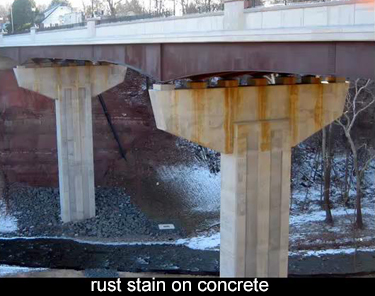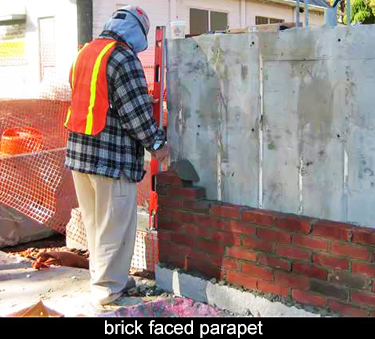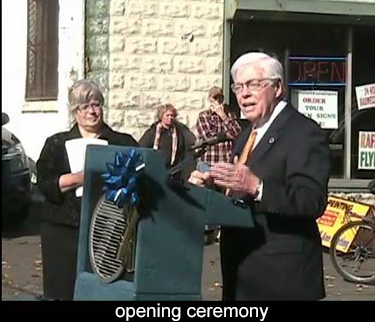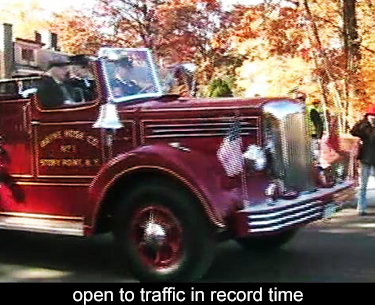This bridge is an example of a remarkably successful project. The planning and the execution have been excellent. Nevertheless, there was one problem, and it's worth having a look at this. The sidewalk area was supposed to include two 4-inch conduits. I think it's evident that there is no room for these conduits, neither below the rebar or above the rebar.
This kind of conflict occurs when the mechanical electrical drawings are not coordinated with the structural drawings. This can be very serious when you're doing a mechanical project, such as wastewater treatment plant. Very often the mechanical electrical work is done in one shop, and the structural work is done someplace else. Invariably, there's a lack of coordination.
There was no simple solution to this problem. It was determined that the conduits would be hung from the underside of the bridge. In this photo, you can see holes are being core drilled through the back wall of the abutment. Eventually the conduits will be run in the space under the bridge. That's a significant change. It was very simple and inexpensive to place the conduits in the sidewalk area. But to hang them under the bridge, to provide the appropriate hangers, to drill and attach hangers to the structural members; all of that is really a significant effort which could have been avoided if the details in the sidewalk had been more carefully worked out.
 The structural steel on this project is Corten steel, which is weathering steel. Weathering steel forms a protective layer on the surface. That layer resists further corrosion. This kind of steel, weathering steel, does not have to be painted. That represents a tremendous saving in terms of the maintenance of the bridge. But the weathered steel will stain the surfaces that it comes in contact with. You can see that on this pier. If weathering steel is used in a building, it will stain the sidewalks. This is a real problem which must be addressed in your design. The bridge details would have to direct any water away from the steel to prevent this washing against the concrete surfaces.
The structural steel on this project is Corten steel, which is weathering steel. Weathering steel forms a protective layer on the surface. That layer resists further corrosion. This kind of steel, weathering steel, does not have to be painted. That represents a tremendous saving in terms of the maintenance of the bridge. But the weathered steel will stain the surfaces that it comes in contact with. You can see that on this pier. If weathering steel is used in a building, it will stain the sidewalks. This is a real problem which must be addressed in your design. The bridge details would have to direct any water away from the steel to prevent this washing against the concrete surfaces.
The staining here took place before the concrete roadway was in place, when the exposed steel could get wet and the runoff is washing down over the piers and abutments. This is very typical of the use of this kind of steel and this occurs all the time. Here is the completed structure. in this bridge, the fascia girder was painted for its full length, and a limited amount of painting was done on the interior members where they were on top of the peers or abutments.
That strategy is probably quite effective in limiting the amount of runoff from the steel onto the concrete surfaces. Nevertheless, this staining took place before all of those protective measures were in place and the bridge really should not be left like this. It may be that over its lifetime, very little additional staining will take place -and we hope that's the case. Very often, because no one was at fault here, this was an inevitable staining, an unavoidable staining, the parties tend to look the other way and pretend that it's not there.
 A lot of care and attention went into the details of the walkway on the bridge. The parapet is faced in brick, and the man doing the work here is called a cornerman. The most highly skilled bricklayer establishes the corners, and that becomes a guide for the rest of the brickwork. The brickwork between the corners is placed with common bricklayers
A lot of care and attention went into the details of the walkway on the bridge. The parapet is faced in brick, and the man doing the work here is called a cornerman. The most highly skilled bricklayer establishes the corners, and that becomes a guide for the rest of the brickwork. The brickwork between the corners is placed with common bricklayers
The Hudson River Valley was famous for its brick manufacturing. Several historic bricks have been saved and some of them were used in the new parapet. One such brick, which seems to be labeled H&R, has been cast into this parapet. All of the features here are very user-friendly and very inviting. The old-fashioned looking light fixture the granite coping on top of the brick-faced wall -and even this fence, this ornamental fence. It's very appropriate for this setting in this historic town.
One of the final activities is saw cutting the pavement to give it a skid proof finish. The concrete finishing machine has already given the concrete a texture by using that transverse drag. But here it's being sawcut as well. After that, there were some housekeeping activities to prepare the bridge for an opening day ceremony in which the local town and the local officials, together with the state officials celebrated the truly remarkable achievement of replacing this bridge in only six months.
 "You know, Joan really is a leader in those first meetings was so accommodating to the supervisor Albert Phillips and Phil Marino and the police departments and fire departments, who had so many problems with trying to close the entire bridge at one time. But she gained the trust of those who were at the table, that she would deliver on time. She gained my trust and therefore I gave my commitment, full-on, that this would be done in less than a year. And it's a reality. And I think it's probably one of the finest jobs, not only in the Hudson Valley, but in the state of New York and serves as a model
"You know, Joan really is a leader in those first meetings was so accommodating to the supervisor Albert Phillips and Phil Marino and the police departments and fire departments, who had so many problems with trying to close the entire bridge at one time. But she gained the trust of those who were at the table, that she would deliver on time. She gained my trust and therefore I gave my commitment, full-on, that this would be done in less than a year. And it's a reality. And I think it's probably one of the finest jobs, not only in the Hudson Valley, but in the state of New York and serves as a model
 We can do for the infrastructure around the state of New York. Joan Dupont, Jeff Rostano from Harrison Burrows were able to pull this off in less than 1 year. We got to give them a big round of applause for that everybody. So from Governor Paterson to the town of Stony Point, to Joan DuPont who's unfortunately leaving us, congratulations -and also to Jeff. Thank you for all your hard work, the dedication. Let's open up this bridge."
We can do for the infrastructure around the state of New York. Joan Dupont, Jeff Rostano from Harrison Burrows were able to pull this off in less than 1 year. We got to give them a big round of applause for that everybody. So from Governor Paterson to the town of Stony Point, to Joan DuPont who's unfortunately leaving us, congratulations -and also to Jeff. Thank you for all your hard work, the dedication. Let's open up this bridge."